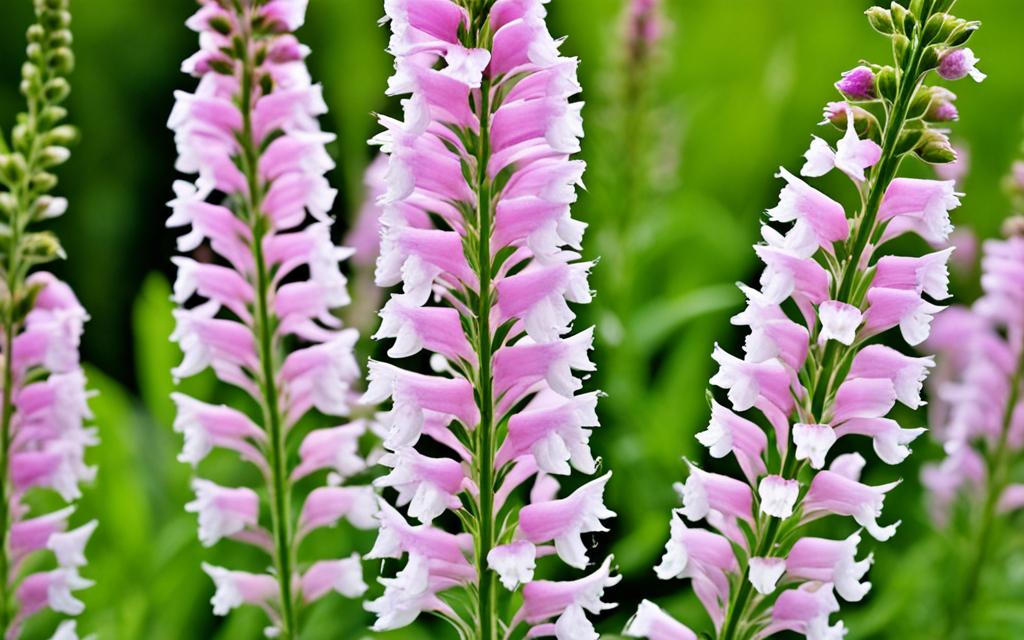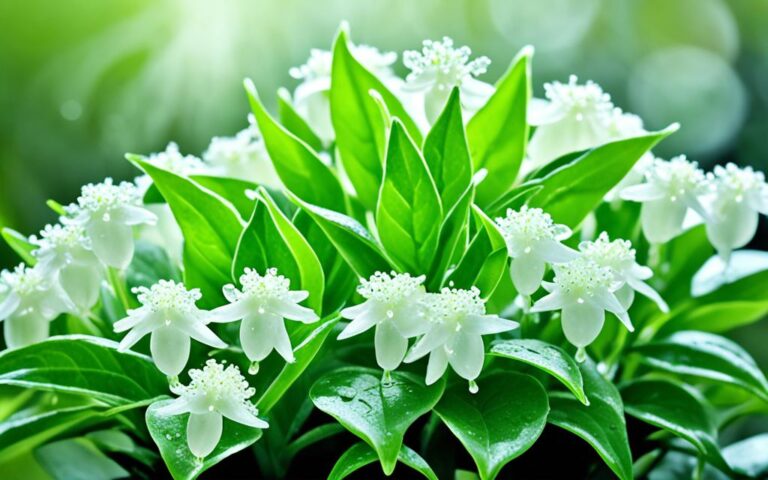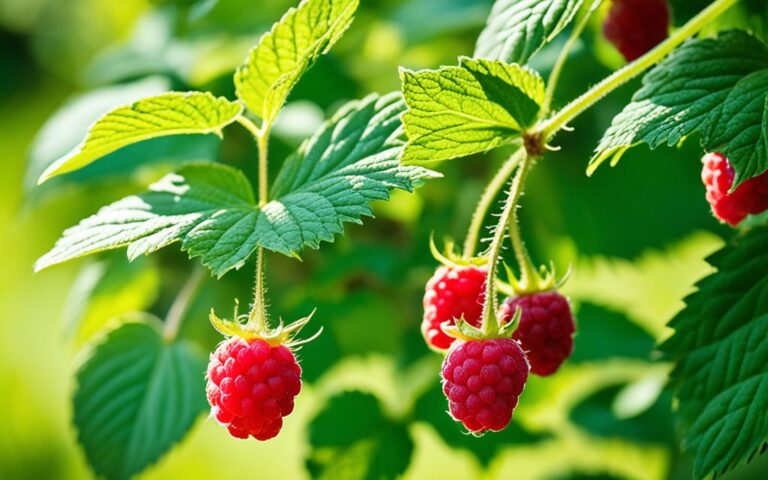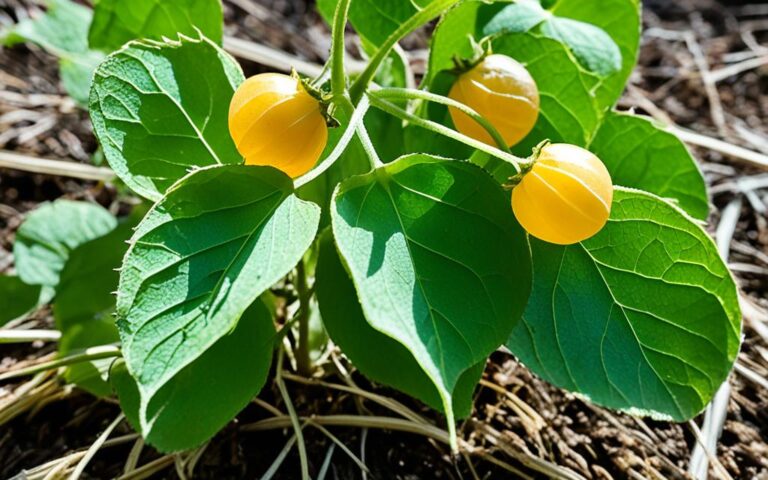Obedient Plant: A Charming Addition to Your Garden
Did you know the obedient plant, also known as Physostegia virginiana, can grow quite tall? It reaches up to 3 feet in height and width. This beautiful perennial brings light pink and white flowers to your garden. Its unique feature is that the flowers can be bent in any direction, hence the “obedient” name.
From late summer to fall, this hardy plant blooms for a month. It’s perfect for a wide range of growing zones, from 3 to 9. This makes it a delightful choice for any garden.
Key Takeaways
- Obedient plant (Physostegia virginiana) is a perennial that grows 1 to 3 feet in height and 2 to 3 feet in width.
- It blooms for about a full month from late summer into fall with light shades of pink and white flowers.
- Obedient plant is suitable for planting in USDA Zones 3 through 9.
- Propagation methods include division and seed.
- The plant is deer-resistant and attracts birds, making it beneficial for pollinator or native plant gardens.
Introducing the Obedient Plant
The obedient plant, known as Physostegia virginiana, is a captivating plant from North America. It belongs to the mint family. This perennial is also called the false dragonhead. It’s famous for its flowers that can be bent and stay in place, hence the name “obedient plant.”
Interesting Facts and Importance
This plant is crucial to the ecosystem, offering nectar to bees, hummingbirds, and butterflies. For centuries, it has been grown in gardens, including Thomas Jefferson’s Monticello.
Common Name Origins
The name “obedient” comes from its flowers that can be turned and kept in place. This unique feature makes Physostegia virginiana a standout in gardens.
| Statistic | Value |
|---|---|
| Native Range | Texas to North Dakota and eastward to the Atlantic and Gulf coasts, with scattered occurrences in New Mexico, Utah, and Montana |
| Flower Characteristics | Puffy, light pink to lavender, sometimes white, with calyxes about half as long as the corollas |
| Pollinators | Hummingbirds, bumblebees, and carpenter bees |
| Other Physostegia Species in Arkansas | Narrowleaf obedient plant, foxglove obedient plant, and slender obedient plant |
“The obedient plant is a fascinating addition to any garden, with its unique ability to have its flowers turned and held in place.”
Identifying Obedient Plant
The obedient plant, known as Physostegia virginiana, is a beautiful perennial. It can grow up to 4 feet tall, adding elegance to any garden. Its square stems and lance-shaped obedient plant foliage stand out. The plant’s flowers can turn and stay in place, earning its name.
Plant Anatomy and Characteristics
The physostegia virginiana characteristics include a tall, straight stem that can be up to 10 inches long. The flowers look like snapdragons and bloom from the bottom up. They come in lavender, pink, and white, drawing in bees and hummingbirds.
The plant’s blue-green foliage contrasts beautifully with its flowers. This makes it a great choice for gardens. To keep it from spreading too much, divide it every few years in spring. Some varieties, like ‘Vivid’ and ‘Pink Manners,’ spread less.
Obedient Plant Varieties
The obedient plant, or Physostegia virginiana, has many beautiful types. These obedient plant cultivars come in different obedient plant colors and sizes. This lets you pick the perfect one for your garden.
Physostegia virginiana ‘Variegata’ is a favorite with its lavender flowers and green and cream leaves. Physostegia virginiana ‘Bouquet Rose’ stands out with its bright pink flowers.
If you want a smaller obedient plant, try Physostegia virginiana ‘Miss Manners’. It grows to 30 inches tall and wide and has white flowers. Physostegia virginiana ‘Alba’ is another option with pure white flowers from natural seedlings.
| Variety | Height | Width | Flower Color |
|---|---|---|---|
| Physostegia virginiana ‘Summer Snow’ | 70-80cm | 30-40cm | White |
| Physostegia virginiana ‘Summerspire’ | 70-80cm | 50-60cm | Pink |
| Physostegia virginiana ‘Rosea’ | 30-35cm | 60-80cm | Pink |
| Physostegia virginiana ‘Crystal Peak White’ | 30-40cm | 30-40cm | White |
These Physostegia virginiana varieties give gardeners many choices. They can pick the obedient plant cultivars that match their garden and style.
Cultivation Requirements
The obedient plant is known for its lovely flowers and easy growth. To make it a great addition to your garden, you need to know its obedient plant growing conditions, obedient plant soil requirements, and obedient plant sunlight needs.
Ideal Growing Conditions
This plant loves full sun to some shade, needing at least 6 hours of sunlight daily. It can grow in many soils, even heavy clay, as long as it’s moist and drains well. The best soil pH is between 5.5 and 6.3, a bit acidic.
Once it’s settled, the obedient plant can handle some drought. But, it grows best with consistent moisture. Too much water can cause wilting, yellowing, and diseases like root rot and mildew.
Soil, Light, and Temperature Needs
- Soil: The obedient plant can grow in a variety of soil types, including heavy clay, as long as the soil is well-drained and consistently moist.
- Sunlight: This plant prefers full sun to partial shade, with at least 6 hours of direct sunlight per day.
- Temperature: The obedient plant thrives in a temperature range of 60-90°F and is winter hardy in USDA Zones 3-9.
Don’t over-fertilize the obedient plant, as it can become too floppy. Keeping the soil, light, and temperature right is crucial for its growth and beautiful flowers.
Planting and Propagation
The obedient plant is known for its lovely blooms and eye-catching look. You can easily grow more of these flowers by sowing seeds or dividing plants. Knowing how to obedient plant planting and obedient plant propagation is crucial.
Sowing Seeds
Starting obedient plants from seeds needs a step: cold stratification. Plant the seeds in pots or trays outside in mid-winter, or start them indoors and move them outside later. After 60 days of cold, the seeds will be ready to grow into healthy plants.
Dividing the Plant
To divide an obedient plant, split its rhizomes, or underground stems. Spring or fall are the best times for this. By dividing the rhizomes and replanting them, you can spread the plant and keep it from taking over your garden.
When you plant obedient plants, make sure to give each one enough space, about 2-3 feet apart. This lets the plant grow well and stops it from spreading too much.
“The obedient plant’s rhizomatous nature makes it a prolific spreader, requiring regular division to maintain control in the garden.”
Care and Maintenance
The obedient plant (Physostegia virginiana) is easy to care for and adds beauty to gardens. To keep your obedient plant looking great, follow these simple tips:
Pruning Techniques
To get more branches and flowers, cut your obedient plant stems back to 3-4 inches in early summer. You don’t need to remove dead flowers, but it helps stop the plant from spreading seeds. In the fall, cut the flower stalks to the ground, leaving the leaves as mulch.
Pest and Disease Management
The obedient plant usually doesn’t get pests or diseases, but might get aphids or blackspot fungus in wet areas. It’s also deer-resistant, which is great for gardens with wildlife.
This plant is easy to care for and grows well in many soils. With these simple tips on obedient plant pruning and pest and disease management, your obedient plant will stay healthy and look great for many years.
Obedient Plant in Containers
The obedient plant is known for its bright flowers and can spread quickly. Growing it in containers helps keep it under control. Make sure the pot is at least 18 inches wide to give the roots enough room.
Use a potting mix with good drainage and add compost for the best results. These plants need more water and food than those in the ground. To protect them in winter, insulate the roots by sinking the pot in the ground or using a bigger container.
When the roots fill the pot, it’s time to move the plant to a bigger one. This lets the plant keep growing and blooming well. Growing obedient plants in pots lets you enjoy their beauty without them taking over your garden.
| Obedient Plant Container Gardening Tips |
|---|
|
By following these tips, gardeners can grow obedient plants in containers. This way, they can enjoy the plant’s beauty without it spreading too much in the garden.
Obedient Plant’s Wildlife Appeal
The obedient plant is a lovely addition to any garden. It offers more than just beauty. Its blooms last long, providing a late-season nectar source for obedient plant pollinators like bees, obedient plant hummingbirds, and obedient plant butterflies. When other flowers are gone, this plant’s tall spikes of flowers attract many pollinators.
This plant is also deer-resistant. This is great for gardens where deer are a problem. You can enjoy the plant’s benefits without worrying about deer eating it.
| Obedient Plant Characteristics | Details |
|---|---|
| Full Sun Required | Obedient Plant (Miss Manners) prefers full sun with at least 6 – 8 hours of direct sunlight per day. |
| Growing Zones | Suitable for zones 4 – 8, indicating adaptable growth across a range of environments. |
| Mature Height and Spread | Stands upright at a height of 24-30 inches with a spread of 18-24 inches, making it a moderately sized perennial. |
| Spacing | For planting a drift of Miss Manners, it is recommended to space individual plants approximately 2 feet apart on center in staggered rows. |
| Attracts Wildlife | Ideal for pollinator gardens as it attracts bees, butterflies, and hummingbirds, contributing to biodiversity. |
The obedient plant is perfect for gardeners who want a thriving, eco-friendly space. By adding this beautiful perennial, you’ll get vibrant blooms and lots of pollinator activity.
Controlling Spread
The obedient plant (Physostegia virginiana) is a native species that’s both useful and can spread quickly. It grows mainly through underground rhizomes, which can spread fast if not managed. To keep it in check, it’s key to remove any unwanted shoots or divisions regularly.
Planting the obedient plant in a container is a good way to stop it from spreading. This method keeps the rhizomes from spreading and controls the plant’s growth. Also, varieties like ‘Miss Manners’ and ‘Pink Manners’ grow more slowly, perfect for smaller gardens.
Even though the obedient plant adds beauty to gardens, controlling its spread is important. By using these strategies, gardeners can enjoy its beauty without it taking over their garden.
Using Obedient Plant in Landscapes
The obedient plant (Physostegia virginiana) is a versatile perennial that can enhance various landscape designs. It has tall, blooming spikes that add height and interest to gardens. It’s great for perennial borders, cottage gardens, and spaces that attract pollinators. Its spreading nature also makes it a good ground cover or erosion control option.
This plant thrives in both sunny and partially shaded areas, making it flexible for many gardens. Its unique, architectural flowers are perfect for cut flower arrangements. They add a special touch to bouquets and floral displays.
Looking to create a lush, colorful border or a low-maintenance groundcover? The obedient plant is a great choice for your obedient plant garden design and obedient plant landscape uses. It’s versatile and attracts wildlife, making it a valuable part of any obedient plant-friendly garden.
| Obedient Plant Landscape Uses | Obedient Plant Garden Design |
|---|---|
|
|
“The obedient plant’s tall, blooming spikes add a whimsical, architectural element to any garden design.”
The obedient plant is a valuable addition to a wide range of obedient plant garden design and obedient plant landscape uses. It’s adaptable and has eye-catching blooms. By adding this perennial, you can make your outdoor spaces both beautiful and friendly to wildlife.
Benefits of Growing Obedient Plant
The obedient plant (Physostegia virginiana) is great for home gardens. It blooms for a long time, from late summer to fall. This makes it stand out when many plants are done blooming.
Its flowers are full of nectar, attracting bees, butterflies, and hummingbirds. These pollinators need food during the winter, and the obedient plant provides it.
This plant is deer-resistant, which is a big plus in areas with deer problems. Its leaves and flowers are usually left alone by deer. It also grows well in many soils and light conditions, making it easy to care for.
If you want to fill your garden with color or create bold areas, the obedient plant is perfect. It spreads out and seeds itself, making it easy to maintain. There are also varieties like ‘Miss Manners’ that don’t spread too much.
The obedient plant is great for gardens because of its long blooms, support for pollinators, deer resistance, and easy growth. It’s perfect for adding color in late season, helping local wildlife, or for a low-care garden. It’s a versatile and rewarding choice.
Conclusion
The obedient plant (Physostegia virginiana) is a charming and versatile perennial. It’s perfect for many home gardens in the United States. It blooms for a long time, attracts pollinators, and grows well in different conditions.
This plant can spread quickly, but gardeners can control its growth. With the right care, it can be a beautiful part of your garden. It attracts wildlife, adds color late in the season, and is deer-resistant.
In short, the obedient plant is great for gardeners who want a low-care, eye-catching, and wildlife-friendly plant. Adding it to your garden brings many benefits. It fits well into the natural environment, making your garden more beautiful and balanced.






